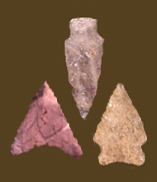
|
SUSQUEHANNA BROADSPEAR
Chronology The Susquehanna Broadspear point dates to the Late Archaic and Transitional periods, and may continue into the beginning of the Early Woodland. Justice (1987) suggests a date range of 3650 to 2650 BP (approximately 2000-800 BC in calendar years), although the more recent end of that range is probably derived from Ritchie (1971) and is not strongly supported by radiocarbon dates. One of the earliest radiocarbon dates for the type is 3670 +/- 140 BP (roughly 2025 BC calendar) at the Corral site in Virginia (Dent 1995). A radiocarbon date of 3600 +/- 80 BP (roughly 1925 BC calendar) was obtained at the Zimmerman site in the Delaware River Valley in Pennsylvania (Kinsey 1972). Dinacauze (1968) reports dates from 3620 +/- 110 BP to 3470 +/- 125 BP (approximately 1975-1750 BC calendar) in New England. A date of 3200 +/- 100 BP (1450 BC calendar) was obtained at the O’Neil site in New York (Funk 1993). Custer (1996a) suggests a date range of 3950 to 3450 BP for the Susquehanna Broadspear in the Middle Atlantic, while Steponaitis (1980) uses 3650 to 3450 BP along the Patuxent River. At the Wilson site in Pennsylvania, Susquehanna Broadspear points were found in association with steatite-tempered pottery, suggesting it could continue into the beginning of the Early Woodland period; a temporal association with early ceramics such as Accokeek Ware has also been noted for the Potomac Valley (McCann 1962; Ayers 1972; Inashima 2008; Egghart 2014). Description Blade: The blade is broad and triangular, with edges that are straight or slightly excurvate. It is biconvex to flat in cross section. The shoulders are usually pronounced, forming an obtuse angle, and can be rounded or sharp. Haft Element: The stem is expanding, usually with sharply constricted neck. The base is usually concave, but is occasionally straight. The base is typically narrower than the shoulders, and its well-defined tangs can be sharp or rounded. The haft element is sometimes canted relative to the blade. Stem edges and the base are generally ground smooth. Size: Length ranges from 34 to 102 mm. Rare examples are as short as 25 mm and as long as 203 mm. Width ranges from 20 to 49 mm. Thickness ranges from 4.75 to 9.5 mm. Technique of manufacture: Many Susquehanna Broadspears appear to have been made from large flakes. Finished points show two chipping stages: initially, there was the broad flaking of the blank, followed by the removal of the corners and re-touching to finish the stem and tangs. In creating a point from a blank, the blade was often only slightly modified by fine re-touching, while the basal portion was more extensively worked. Material: In a sample of 44 Susquehanna Broadspears from the lower Patuxent drainage, Steponaitis (1980) reported that 48% were rhyolite, followed by quartzite (29%), quartz (9%), chert (7%), argillite (5%), and other materials (2%). In the area surrounding Zekiah Swamp on the lower Potomac, Wanser (1982) found that 55% of 77 Susquehanna Broadspear points were quartz, with 26% quartzite, 14% rhyolite, and 1% each of chert, jasper, and other materials. Of the 124 mostly surface-collected Susquehanna Broadspears recorded during the Monocacy River drainage survey, 92% were rhyolite, 6% quartz, 1% quartzite, and 1% chert, while all ten examples excavated at the deeply stratified Monocacy site in Frederick County were rhyolite (Ayers 1972; Kavanagh 1982). In the Hagerstown Valley, a majority of Susquehanna Broadspears were rhyolite, followed by lesser amounts of chert and jasper (Stewart 1980). In the middle Potomac Valley, rhyolite Susquehanna Broadspears are most common, but other materials are occasionally used (Hranicky 2002). In Delaware, rhyolite and argillite are the most common materials used (Custer 1996a), while in Virginia, rhyolite predominates, but quartz and quartzite are also used, particularly in the coastal plain and southern parts of the state (McLearen 1991). A preference for banded rhyolite has been noted in Maryland (Carol Ebright 2012, personal communication). Discussion The type overlaps chronologically and morphologically with the Perkiomen and Fishtail points (the latter could even represent an end-stage for individual Susquehanna Broadspears), and all three are part of the Susquehanna Cluster (Ritchie 1971; Justice 1987; Funk 1993). This overlap may account for some of the younger dates reported for the Susquehanna Broadspear. The Wayland Notched point in New England and the Ashtabula point in the Ohio Valley are also similar types (Justice 1987). Defined in Literature This type was defined by Witthoft (1953) based on points recovered from eastern Pennsylvania, and was originally called the Susquehanna Broad Spearpoint. He considered it a characteristic artifact of what he termed the Susquehanna Soapstone Culture, a concept built in part on data from several related Transitional period sites along the Potomac. References |
![]()
Search by Shape:
(See Projectile Point Typology) |

|
Thank you for visiting our website. If you have any
questions, comments, Copyright © 2002 by |

|

 Defining Attributes
Defining Attributes